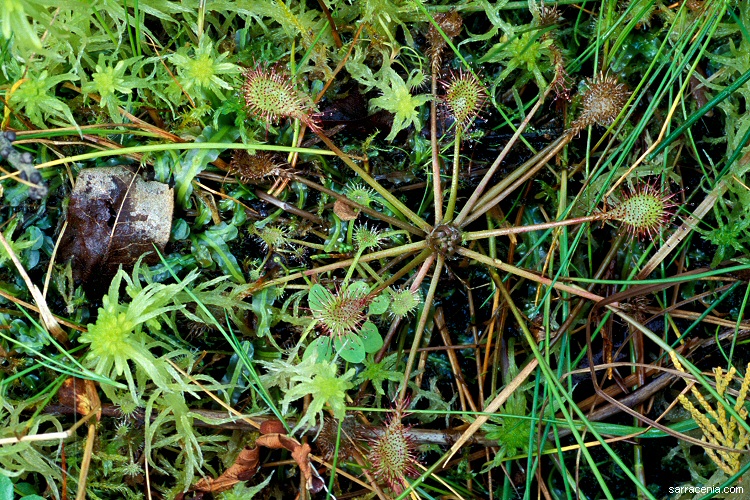
Sundews!
Ah yes, nice sundews, just entering winter dormancy!
This plant had me scratching my head for a while. Obviously it is not Drosera rotundifolia,
but I thought it just did not look right for D. intermedia (the only reasonable alternative). For a while I thought it
might be the hybrid between the two (i.e. D.×beleziana), but John Phillip, Jr. (a
carnivorous plant explorer from the area) has
convinced me that this is just what D. intermedia looks like in this part of the world. It is interesting how
different these are from the strongly stemmy New Jersey plants.
To the left of the large plant, you can see a much smaller sundew entering
dormancy--a young Drosera rotundifolia. In fact,
D. rotundifolia plants were common, but they were not pretty enough to photograph
as they were slugging it out with the rapidly
growing, competitive Sphagnum. (Did you notice the single D. rotundifolia leaf in the image
three slides ago? It is between the two large pitcher hoods.)
After this photograph, it was time to call it a day for this site. We
gathered up our gear and headed back through the forest to the car, and then on to our motel. We had only a few hours before
any urushiol from the poison sumac bonded to the proteins in our skin, and we did not know how much exposure we had
received. We spent a long time cleaning ourselves off in the motel! All our clothes were bagged and
treated like toxic waste until we could launder them. If you have ever had bad reactions with
Toxicodendron plants (I have only had it once, and it was memorable), you understand our concerns.
Beth and I took several other field trips during this trip, but only one was focused on carnivorous plants. It was to a pond
in Rhode Island. The trailhead was easy enough to find, but we apparently bypassed an important turnoff,
and so walked for more than an hour on trails that--while pretty--did not take us to the destination that our hearts
sought. In time, we abandoned the forest trails and hopped onto a road I saw through the trees. We remembered
we had been on this road before, and estimated that by following it we would get to our car faster than by backtracking
on the forest paths; but even so, we would be back at the car after sunset, and we walked briskly and with some
nervousness as the occasional stray dog barked at us in the ever-darkening gloaming.
Fortunately, we met some folks in a car who happened to be stewards for the
preserve, and who kindly drove us the final mile to our car. En route, they
told us that, yes, there were carnivorous plants at the site, and that we had gotten within just a few hundred
meters of them on our winding path. Dang! We were so
close! Add this to my unsatisfying photographic experience with U. geminiscapa, as another
reason that I wanted to come back to the carnivorous plants of New
England.
The rest of our trip to New England was spent on non-carnivorous plant pursuits.1
1Fans of HPL will approve that we spent half a day in Providence,
visiting significant houses in the College Hill area. I have a whole set of these photographs on line on my Facebook page,
so to see them you'll have to head there....